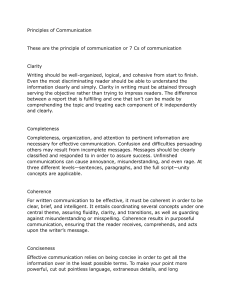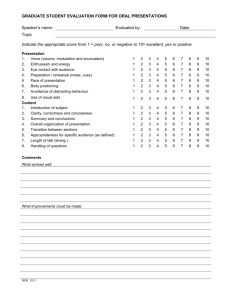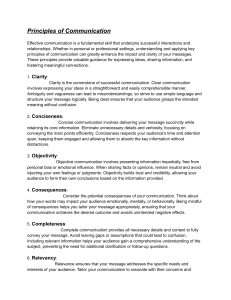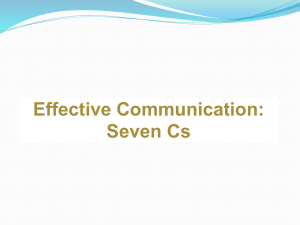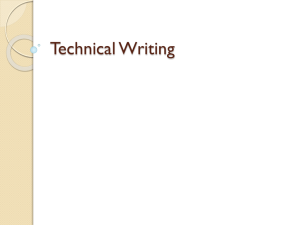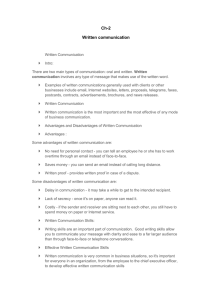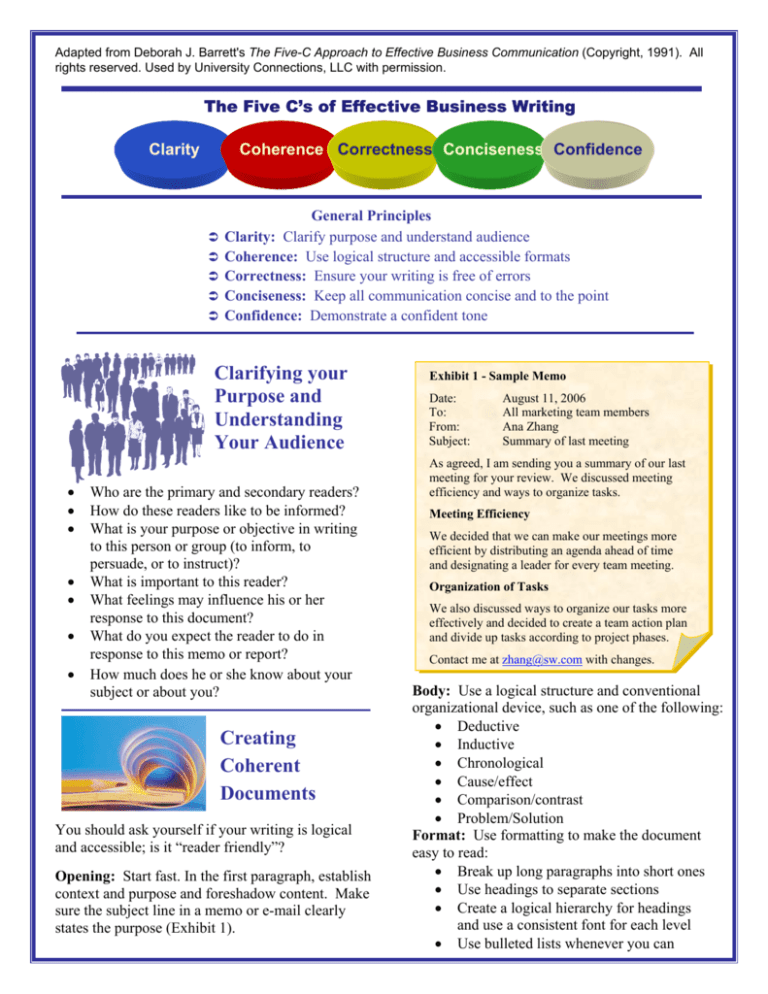
Adapted from Deborah J. Barrett's The Five-C Approach to Effective Business Communication (Copyright, 1991). All
rights reserved. Used by University Connections, LLC with permission.
The Five C’s of Effective Business Writing
Clarity
Clarity
Coherence
Coherence Correctness
Correctness Conciseness
Conciseness Confidence
Confidence
Â
Â
Â
Â
Â
General Principles
Clarity: Clarify purpose and understand audience
Coherence: Use logical structure and accessible formats
Correctness: Ensure your writing is free of errors
Conciseness: Keep all communication concise and to the point
Confidence: Demonstrate a confident tone
Clarifying your
Purpose and
Understanding
Your Audience
•
•
•
•
•
•
•
Who are the primary and secondary readers?
How do these readers like to be informed?
What is your purpose or objective in writing
to this person or group (to inform, to
persuade, or to instruct)?
What is important to this reader?
What feelings may influence his or her
response to this document?
What do you expect the reader to do in
response to this memo or report?
How much does he or she know about your
subject or about you?
Creating
Coherent
Documents
You should ask yourself if your writing is logical
and accessible; is it “reader friendly”?
Opening: Start fast. In the first paragraph, establish
context and purpose and foreshadow content. Make
sure the subject line in a memo or e-mail clearly
states the purpose (Exhibit 1).
Exhibit 1 - Sample Memo
Date:
To:
From:
Subject:
August 11, 2006
All marketing team members
Ana Zhang
Summary of last meeting
As agreed, I am sending you a summary of our last
meeting for your review. We discussed meeting
efficiency and ways to organize tasks.
Meeting Efficiency
We decided that we can make our meetings more
efficient by distributing an agenda ahead of time
and designating a leader for every team meeting.
Organization of Tasks
We also discussed ways to organize our tasks more
effectively and decided to create a team action plan
and divide up tasks according to project phases.
Contact me at zhang@sw.com with changes.
Body: Use a logical structure and conventional
organizational device, such as one of the following:
• Deductive
• Inductive
• Chronological
• Cause/effect
• Comparison/contrast
• Problem/Solution
Format: Use formatting to make the document
easy to read:
• Break up long paragraphs into short ones
• Use headings to separate sections
• Create a logical hierarchy for headings
and use a consistent font for each level
• Use bulleted lists whenever you can
Five-C's of Effective Business Writing - Continued
Ensuring your
Communication
is Correct
Information
• Is your information accurate?
• Have you presented it correctly?
• Have you double-checked all numbers?
Usage
• Have you followed conventional business
grammar and spelling rules? Check the list of
the top 20 most distracting errors to make sure
you have not made any of them.
• Have you used all words correctly?
• Have you run spell check but not relied solely
on it to catch all errors?
• Have you printed the document and proofread
it carefully?
Using the Five
Rules for
Making Writing
Concise
1. Test the importance of what you have written
by asking, “Can anyone say ‘so what’ to that?”
2. Use action verbs (e.g., capture, alter,
maintain, etc.) and avoid passive voice.
3. Always keep your audience in mind: what
do they need to know vs. what may be nice
for them to know.
4. Avoid prepositional idioms (e.g., due to the
fact that, for the purpose of, in order to,
etc.) and eliminate all excess words (the
fewer words used, the better).
5. Avoid repetition and redundancy.
Demonstrating
a Confident
Tone
1. Establish a positive ethos: think credibility,
suggesting who you are, that you know what
you are talking about, and that you and your
organization can be trusted.
2. Be careful not to use too many modifiers,
empty words, or weasel words (e.g., almost,
like, virtually, things, etc.).
3. Stay away from expressions, such as “in my
opinion,” “I think,” and “I believe.”
4. Use strong verbs and avoid passive voice.
5. Trust yourself and your knowledge about the
subject, but be careful not to sound as if
your way is the only way.
This Five-C Overview is brought to you by
For more best practices,
contact Jim Lavis at
jlavis@university-connections.com
713-626-2606

